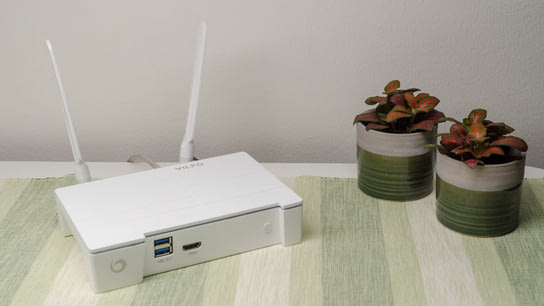Vilfo is an upcoming VPN client gateway intended for home users to shield their activities from their internet service provider. It’s much more powerful (and expensive) than your average VPN capable home router, but is powerful hardware all it takes to make a good VPN gateway?
What is the Vilfo?
Vilfo is a powerful 430 USD network router using mini-PC hardware rather than the traditional barely-enough processing power you can expect from a traditional router. Vilfo envisions you’ll use this extra processing power to encrypt all your traffic and tunnel it through to a remote virtual private network (VPN) provider.
Protect your home with a VPN router
Vilfo website
I’m somewhat unclear on what exactly the Vilfo is designed to protect against. A VPN service provider won’t make you anonymous on the web; it merely shifts were your traffic emerges from your home to a server farm somewhere else in the world. A VPN service is most useful when you access the web from an untrusted network (such as a café Wi-Fi network) and don’t want other people on the same network to see your internet traffic. Vilfo does however suggest some use cases for home users:
Browse safely online, access blocked content overseas & setup your favourite VPN provider in seconds
Vilfo crowd-funding campaign, Indiegogo
It’s intended to be used to bypass geographical restrictions on digital content (something the European Union is already working to abolish). However, design flaws make it unsuitable for the task. Vilfo leaks information about the domains you visit, and it certainly isn’t designed for security or privacy. I cover this in much more detail in Part 3.
Software
Vilfo is based on the open-source Linux-based OpenWRT (actually LEDE Project which has since merged with OpenWRT) with a custom web administrative interface on top that focuses on configuring and selling VPN services. OpenWRT is a solid base for any network router, and they can be a great template for developing a commercial product.
The initial setup requires you to connect to the Vilfo over a password-less Wi-Fi connection, and type in the router’s IP address in your browser. You then wait for a minute or two on a empty page with a progress spinner before you’re guided through the setup process. Part 3 goes into detail on security issues with this process.
I’d like to take a minute to note that the Vilfo isn’t suited for anyone who needs to use any assistive technologies like a screen reader. The first page has you waiting for one minute on an entirely blank page with no feedback what so ever. This frustrating and confusing experience is representative for the Vilfo web interface as a whole. A sighted person with all senses in order won’t have any problems using the Vilfo, but its not at all optimized for assistive technologies.
The web interface is easier to use than most home routers I’ve encountered. It sacrifices features and focus on its strengths: being a simple router and an easy-to-configure VPN gateway. This may sound complex, but Vilfo makes it relatively easy.
The web administration interface could have benefited from being more task-oriented as its not always clear what you need to do next. You can chat with the Vilfo support staff right from the web administration interface; which raises some privacy issues I cover in Part 3.
Vilfo also features some pretty graphs to give you insights on the devices that connect to your network.
Vilfo let you group devices on your network (by MAC address) and assign each device group to a VPN provider, or different server farm location from the same provider. You can set up multiple VPN providers and route different devices to different providers. This isn’t a unique feature, but Vilfo certainly has made it much easier to do than your average router.
Hardware
Unlike most routers, the Vilfo VPN router is a regular mini-PC in a box. It even has an HDMI port and USB so you can plugin a screen, and keyboard and mice to re-purpose it as a mini-computer. If you pop open the cover, you’ll even find a few internal extension ports and a SD-card reader.
Specifically, you’ll find a Qotom Q310G4-4 board with an Intel Celeron 3215U processor, 2 GiB of RAM, a 16 GB SSD, and a single MediaTek MT7612E Wi-Fi module. While the processor is remarkable, the Wi-Fi leaves a lot to be desired. I’ll get back to the Wi-Fi in much greater detail in Part 2: As a Wi-Fi access point.
As a standard PC the Vilfo uses standard PC components; which you could technically upgrade if the need arise. The SSD is a standard PCI Express, and the Wi-Fi module is a standard PCI Express half-length card. (There’s room for two full-length PCI Express cards.)
You can get the same Qotom Q310G4-4 with an Atheros AR9287 Wi-Fi module, a 32 GB SSD, and a heat dissipating black aluminum chassis pre-installed with pfSense (a FreeBSD based router operating system) direct from Qotom on Amazon or AliExpress retailing at around 185 USD.
Continue to Part 2: Vilfo as a Wi-Fi access point.
